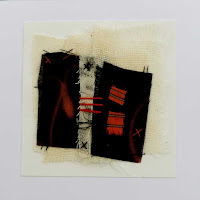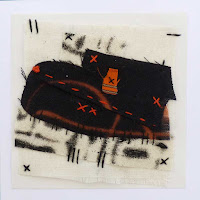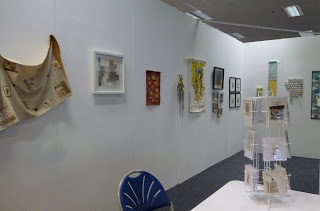These little cards have been prepared for Swindon Open Studios next weekend, 22nd and 23rd September. As I posted here previously, I will have work on show and for sale with Great Western Embroiderers in Cricklade United Church Hall and will be manning my table both days, ready to talk about what I do. It will be a pleasure to see you if you live close enough to come.
They feature tiny abstract pieces (around 3 inches square) and are a different approach for me since they are simply impromptu experiments in stitch and cloth. There has been no preliminary photographing, planning through sketchbook work or forethought of any kind - and there is no conscious underlying imagery at play. I just went to my fabric stash, chose a small selection that appealed to me and selected threads in an appropriate palette.
They feature tiny abstract pieces (around 3 inches square) and are a different approach for me since they are simply impromptu experiments in stitch and cloth. There has been no preliminary photographing, planning through sketchbook work or forethought of any kind - and there is no conscious underlying imagery at play. I just went to my fabric stash, chose a small selection that appealed to me and selected threads in an appropriate palette.
 |  |  |
 |  |  |
Thus the pressure was off and I played. My main thoughts, I suppose, were with stitch (as both construction and decoration) and with shape, although there was some conscious use of texture and pattern. I also explored diagonals and intersections and the careful posititioning of stitch.
The whole thing has been a very entertaining break for me, though it was surprisingly taxing to do with every decision to be made on the spot. Stitch in my abstract pieces is mainly for construction and in my more representational pieces is generally for decoration and the development of imagery. It is rarely both in the one piece ... something to take forward, perhaps?
Another thought (not a new one for me) was that more is often too much and simpler is better. I always have to remember that.
The whole thing has been a very entertaining break for me, though it was surprisingly taxing to do with every decision to be made on the spot. Stitch in my abstract pieces is mainly for construction and in my more representational pieces is generally for decoration and the development of imagery. It is rarely both in the one piece ... something to take forward, perhaps?
Another thought (not a new one for me) was that more is often too much and simpler is better. I always have to remember that.
So, nothing is ever done completely in isolation, whatever one may think!
*Full details of Swindon Open Studios and the other contributors is to be found on their website here.













